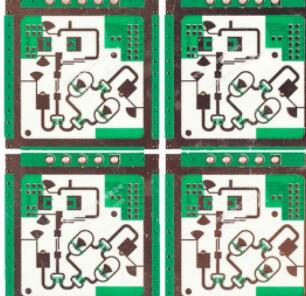The high frequency of electronic equipment is the development trend, especially under the increasing development of wireless networks and satellite communications, information products are moving towards high speed and high frequency, and communication products are moving towards the standardization of voice, video and data for wireless transmission with large capacity and speed. Therefore, the development of a new generation of products requires PCB high-frequency circuit boards.
The customer groups of PCB high-frequency circuit boards include base station satellite systems, mobile phone receiving base stations and other communication products. These products must use high-frequency circuit boards. In the next few years, they will inevitably develop rapidly, and high-frequency substrates will be in large demand.
The basic characteristics of PCB high-frequency circuit board substrate materials are as follows:
1. Other heat resistance, chemical resistance, impact strength, peel strength, etc. must also be good.
2. Low water absorption and high water absorption will affect the dielectric constant and dielectric loss when damp.
3. Try to be consistent with the thermal expansion coefficient of the copper foil, because inconsistencies will cause the copper foil to separate in the cold and heat changes.
4. The dielectric loss (Df) must be small, which mainly affects the quality of signal transmission. The smaller the dielectric loss, the smaller the signal loss.
5. The dielectric constant (Dk) must be small and stable. Generally, the smaller the better, the signal transmission rate is inversely proportional to the square root of the material's dielectric constant. High dielectric constant is likely to cause signal transmission delay.
Generally speaking, the high frequency of PCB high-frequency microwave radio frequency board/high-frequency board can be defined as the frequency above 1GHz. At present, the most commonly used high-frequency circuit board substrate is a fluorine-based dielectric substrate, such as polytetrafluoroethylene (PTFE), Usually called Teflon, usually used above 5GHz. In addition, there are FR-4 or PPO substrates, which can be used for products between 1GHz and 10GHz. The high frequency of these three types of high-frequency circuit boards

The physical properties of frequency substrates are compared as follows.
At this stage, the three types of high-frequency substrate materials: epoxy resin, PPO resin and fluorine-based resin are the cheapest cost of epoxy resin and the most expensive fluorine-based resin; and the dielectric constant, dielectric loss, and water absorption rate Considering the frequency characteristics, fluorine resin is the best and epoxy resin is inferior. When the frequency of the product application is higher than 10GHz, only the fluorine-based resin printed board can be applied. Obvious
Fluorine-based resin high-frequency substrate performance is much higher than other substrates, but its shortcomings are poor rigidity and large thermal expansion coefficient in addition to high cost. For polytetrafluoroethylene (PTFE), in order to improve performance, a large amount of inorganic substances (such as silica SiO2) or glass cloth are used as reinforcing fillers to increase the rigidity of the substrate and reduce its thermal expansion. In addition, due to the molecular inertness of the PTFE resin itself, it is not easy to bond with copper foil, so special surface treatment of the bonding surface with copper foil is required. The treatment method includes chemical etching or plasma etching on the surface of PTFE to increase the surface roughness or add a layer of adhesive film between the copper foil and the PTFE resin to improve the bonding force, but it may affect the performance of the medium. Influence.
The development of high-frequency substrates for the entire fluorine-based high-frequency circuit board requires the cooperation of raw material suppliers, research units, equipment suppliers, PCB circuit board manufacturers, and communication product manufacturers to keep up with PCB high-frequency circuit boards. The need for rapid development in this field.